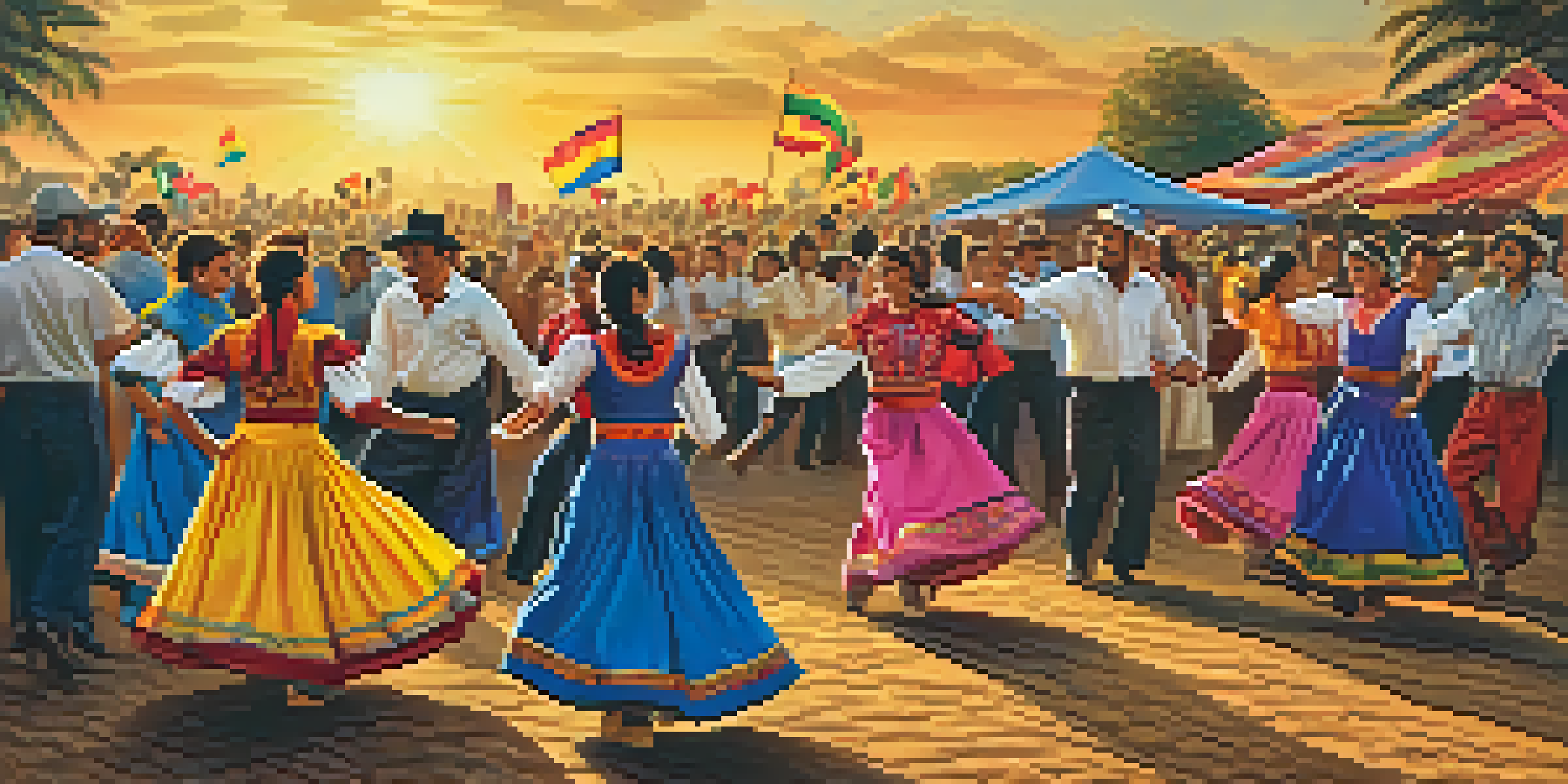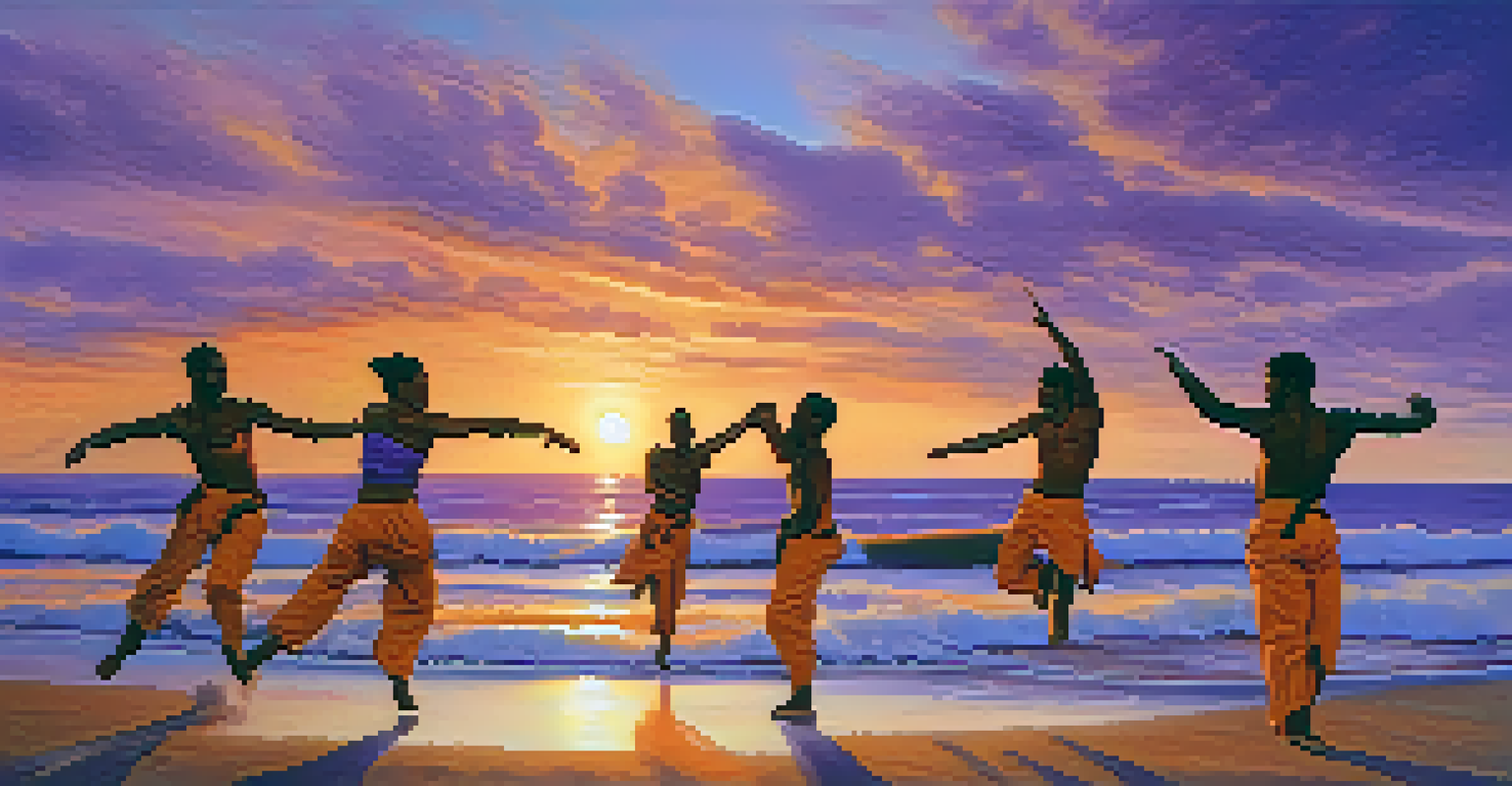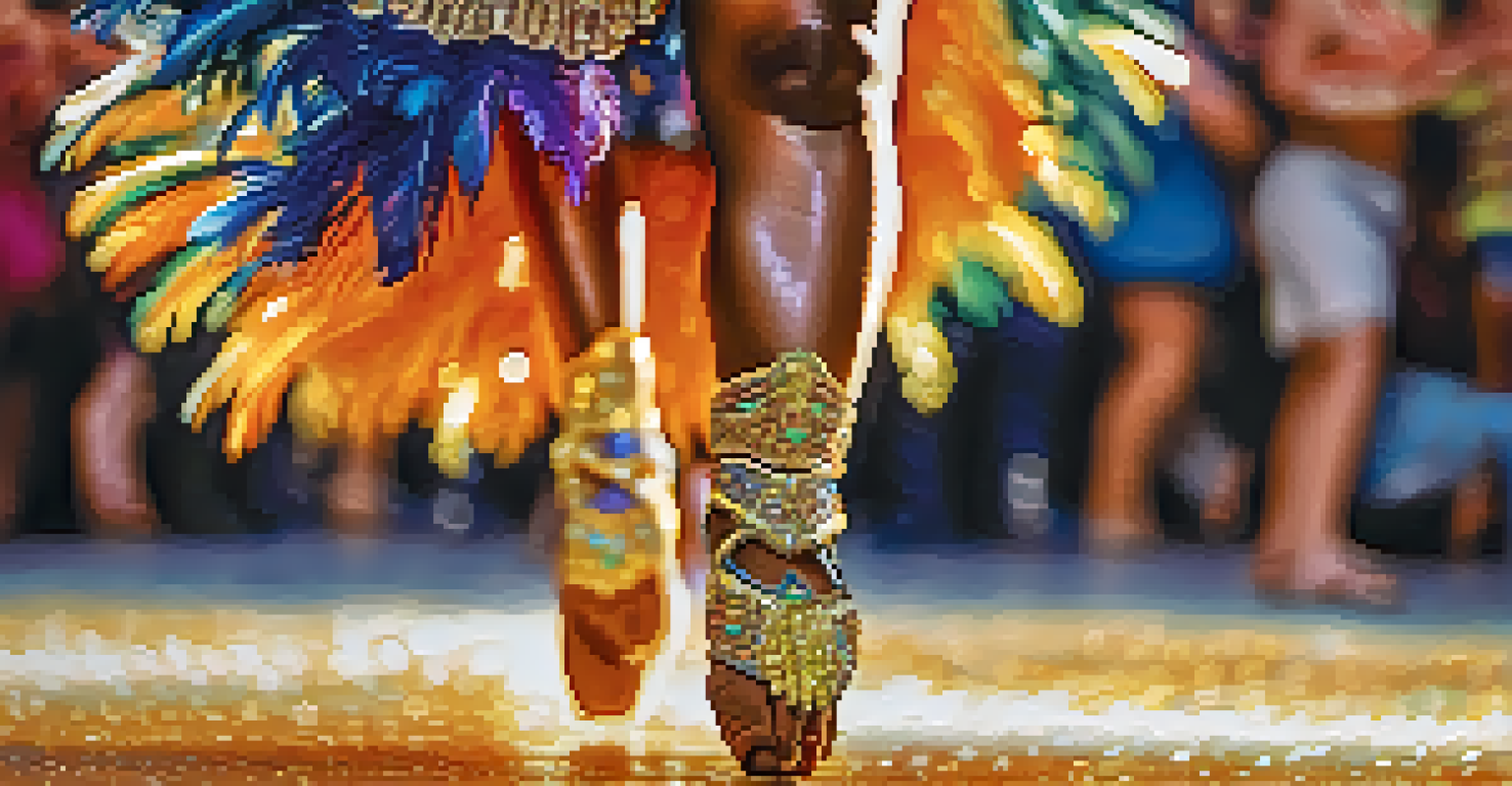Dance as a Storytelling Medium in Brazilian Folklore Festivals

The Role of Dance in Brazilian Culture and Folklore
Dance in Brazil is more than just movement; it’s a vital expression of culture and identity. From samba to capoeira, each dance form embodies unique stories and traditions, often passed down through generations. These dances serve as a vibrant medium for storytelling, connecting the past with the present.
Dance is the hidden language of the soul.
In Brazilian folklore, dance acts as a bridge, allowing communities to remember their roots while celebrating their heritage. Festivals become lively stages where stories unfold, showcasing everything from mythical creatures to historical events. This connection fosters a sense of belonging among participants and audiences alike.
Additionally, the rhythmic beats and colorful costumes enhance the storytelling experience, making it more immersive. As dancers embody characters and emotions, they invite spectators into their world, creating a shared narrative that resonates deeply within Brazilian society.
Key Folklore Festivals Celebrating Dance
Brazil boasts numerous folklore festivals where dance takes center stage, each with its unique flair. The Festa Junina is one such celebration, featuring traditional dances like the quadrilha, which tells the story of rural life and love. Participants don festive attire, creating a visual feast that complements the lively storytelling.

Another prominent event is the Festival de Parintins, which showcases the legendary tale of the Boi-Bumbá. Here, dance brings to life the rivalry between two groups, each presenting their interpretation of the story through elaborate performances. The energy is contagious, engaging both locals and tourists in the narrative.
Dance as Cultural Expression
Dance in Brazil serves as a vital expression of culture, connecting communities to their heritage through storytelling.
These festivals serve as a reminder of the power of dance to convey stories that resonate across age groups and cultures. They highlight how dance can preserve history while evolving with contemporary influences, ensuring that these tales remain relevant.
Dance Forms as Narrative Tools
Different dance forms in Brazilian folklore each tell distinct stories, using movement, rhythm, and expression. For instance, the samba, often associated with Carnival, narrates tales of joy, struggle, and resilience through its lively beats and intricate footwork. The dancers embody the spirit of celebration while reflecting on Brazil's complex history.
The dance is a poem of which each movement is a word.
Capoeira, on the other hand, tells a story of resistance and cultural survival. This martial art combines dance, acrobatics, and music, showcasing the struggle against oppression while celebrating freedom. Its fluid movements and playful interactions between dancers convey a narrative of both conflict and camaraderie.
These forms illustrate how dance can transcend mere entertainment; it becomes a vehicle for storytelling, allowing artists to communicate profound messages through their movements. Each step and gesture is intentional, inviting the audience to engage with the story on a deeper level.
The Importance of Community in Dance Storytelling
Community plays a crucial role in the storytelling aspect of dance within Brazilian folklore. Festivals often involve entire neighborhoods, fostering a sense of unity and shared identity. Together, they celebrate their traditions through dance, reinforcing cultural values and historical narratives.
Moreover, the collaborative nature of these performances encourages participation, allowing everyone to contribute to the storytelling process. Whether it's through dancing, drumming, or singing, community involvement ensures that stories are not just told but experienced collectively.
Festivals Celebrate Dance Narratives
Folklore festivals like Festa Junina and Festival de Parintins highlight the power of dance in preserving and sharing historical narratives.
This communal engagement enriches the narrative, as various perspectives and interpretations come together. It transforms dance into a shared journey, where individuals feel connected not only to the story being told but also to each other.
Emotional Resonance in Dance Storytelling
Dance as a storytelling medium evokes a range of emotions, creating a powerful connection between performers and audiences. When dancers convey joy, sorrow, or triumph, they invite spectators to experience these feelings alongside them. This emotional resonance is what makes dance a profound form of storytelling.
In Brazilian folklore, the expressive nature of dance amplifies the narrative's impact, allowing for a deeper understanding of cultural themes. For instance, the melancholic movements in certain dances can evoke empathy, drawing audiences into the characters' experiences and struggles.
Through this emotional exchange, dance transcends language barriers, communicating universal themes that anyone can relate to. It emphasizes the idea that storytelling through dance is not just about the narrative itself, but also about the connections it fosters among people.
Modern Influences on Traditional Dance Narratives
As society evolves, so too does the storytelling aspect of dance in Brazilian folklore. Contemporary influences have led to innovative interpretations of traditional dances, blending old and new styles to create fresh narratives. This evolution reflects the dynamic nature of culture and the desire to keep stories alive.
For instance, many modern choreographers incorporate elements of hip-hop and contemporary dance into traditional forms, creating exciting fusions that attract younger audiences. These adaptations not only preserve the essence of the original stories but also make them accessible and relatable to today’s generation.
Community Enriches Dance Storytelling
The communal aspect of dance performances fosters unity and shared identity, allowing for collective storytelling and emotional resonance.
However, this blending can spark discussions about cultural authenticity and preservation. It's essential to strike a balance between innovation and respect for tradition, ensuring that the rich narratives of Brazilian folklore continue to thrive while adapting to contemporary contexts.
The Future of Dance as a Storytelling Medium
Looking ahead, the future of dance as a storytelling medium in Brazilian folklore seems promising. With the rise of digital platforms, performances can reach wider audiences, allowing stories to transcend geographical boundaries. This accessibility can introduce global audiences to the rich tapestry of Brazilian culture and its narratives.
Furthermore, the continued fusion of styles may lead to new forms of storytelling, enriching the cultural landscape. As artists experiment with different mediums, including film and virtual reality, the narratives expressed through dance can evolve in exciting ways.

Ultimately, the essence of storytelling through dance will remain rooted in community and cultural expression. As long as there are stories to tell and people willing to share them, dance will continue to be a vital medium for storytelling in Brazilian folklore festivals.